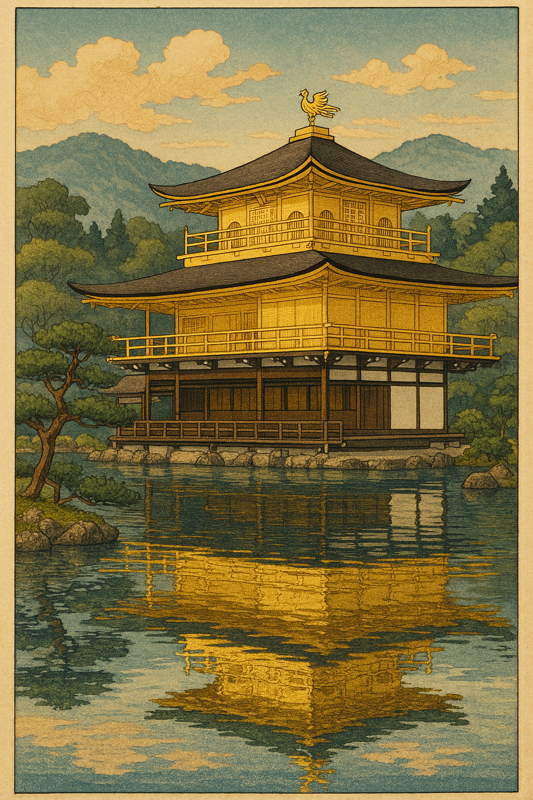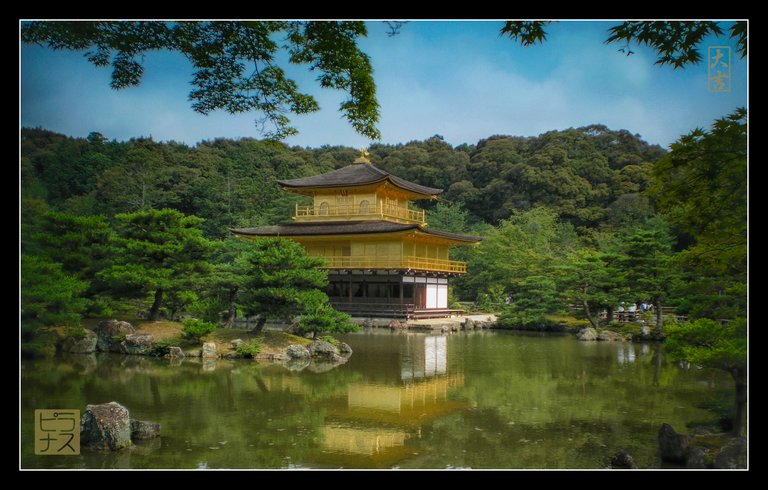Kinkakuji: A Golden Legacy of Fire and Faith

I’ve seen a lot of gold in my time — from coins to collectibles — but few things shine quite like Kyoto’s Kinkakuji. Unlike bullion bars locked away in vaults, this one gleams in the open air, mirrored in a quiet pond, glittering beneath the changing seasons.
The Birth of the Golden Pavilion
Kinkakuji, formally known as Rokuon-ji, traces its origins back to the 1390s, when Japan was still ruled by shoguns, and Zen Buddhism held serious sway over the ruling class. The villa was originally built as a retirement home for Ashikaga Yoshimitsu, the third shogun of the Muromachi period. A powerful political figure and lavish patron of the arts, Yoshimitsu was fascinated by Chinese culture, especially the Ming Dynasty’s aesthetics — he wanted a retreat that would reflect not just his wealth, but also his embrace of Zen and classical Chinese design.
[I’ve written about Yoshimitsu in more detail before. Read it here]
After his death, Yoshimitsu’s son converted the villa into a Zen Buddhist temple, as his father had wished. The temple became famous almost immediately, not for its religious function, but for its aesthetic: the second and third floors were coated in real gold leaf. This wasn’t mere gilded decoration — it was a physical statement of impermanence and spiritual radiance, two paradoxes that Zen Buddhism embraces wholeheartedly.
But like all things that glimmer, it wouldn’t last.
Fire and Madness: The Arson of 1950
By the mid–20th century, Kinkakuji had survived wars, weather, and political turmoil. But it couldn’t survive a troubled young monk.
In the early morning hours of July 2, 1950, the pavilion was set ablaze by 22-year-old Hayashi Yoken, a novice monk at the temple. The structure, already fragile from centuries of exposure, was quickly engulfed in flames and burned to the ground. Only a handful of artifacts (some statues and relics) were saved.
Yoken’s motives have long been debated. Official accounts describe him as mentally unstable, deeply conflicted between his ideals of spiritual purity and the overwhelming allure of the golden structure he served. Some say it was jealousy. Others believe it was an act of twisted devotion. After the fire, he attempted suicide on the slopes of Mt. Kinugasa but survived and was later institutionalized. His story was fictionalized — most famously — in Yukio Mishima’s 1956 novel The Temple of the Golden Pavilion, which transformed the incident into a haunting exploration of obsession and destruction.[1]
Rebuilding a Symbol
In 1955, Kinkakuji was rebuilt to its original design, using detailed plans and photographs as guides. But this time, the gold leaf wasn’t just a historical reference — it was a restoration of grandeur. The top two floors were fully re-coated in gold leaf, and in 1987, an even thicker layer was applied during renovation, using nearly 20 kilograms of gold.
Think about that — 20 kilograms. At today’s prices, that’s around $1.5 million worth of gold — just sitting out there in the open. Try not to drool.
The phoenix atop the roof is also gold-plated, adding an even more mythic flourish to a building already overflowing with symbolism. The result is a structure that glows like flame in the autumn sun, glints icily in winter snow, and seems almost otherworldly in the green of summer.
Gold, Tourists, and the School Trip Pilgrimage
Kinkakuji today is one of Japan’s most photographed sites, and easily the most visited temple in Kyoto. Despite its religious designation, it’s not really a place of prayer. There’s no public access inside. Visitors follow a roped path around the temple’s pond, snap their photos, maybe buy a matcha soft cream or a gold-leaf souvenir, and move on.
For tourists, it’s a must-see. For Japanese students, it’s practically a rite of passage. Every spring and fall, middle school and high school students pour into Kyoto on school-sponsored shūgakuryokō (field trips), and Kinkakuji is always on the itinerary. Always. In fact, chances are pretty good that if you visit the temple, there will be a school trip when you’re there and you will be dodging kids. Even kids who roll their eyes at temples are struck by this one — because it’s gold.
Not faux gold. Not paint. Real gold leaf. And everyone who sees it for the first time says the same thing: it’s smaller than they imagined. But more beautiful.
Gold as Symbol and Surface
Kinkakuji is more than just a tourist trap or postcard cliché. It’s a symbol of how Japan plays with surface and substance. The gold is both real and metaphorical: it dazzles and distracts, but also points toward something deeper — an aesthetic philosophy where beauty, like wealth, is fleeting.
It also speaks to Japan’s paradoxical view of opulence. In Zen, gold is not something to hoard, but something to burnish the spirit. Ashikaga Yoshimitsu didn’t build a fortress of gold — he built a meditation.
Final Reflections
There are gold coins that sit untouched in safes for decades, never catching the light. And then there’s Kinkakuji — a golden structure that reflects light, weather, and time itself.

-
It’s worth a read. Here’s the Wikipedia entry if you want to read about it. ↩
❦
 |
David is an American teacher and translator lost in Japan, trying to capture the beauty of this country one photo at a time and searching for the perfect haiku. He blogs here and at laspina.org. Write him on Mastodon. |
You received an upvote of 100% from Precious the Silver Mermaid!
Thank you for contributing more great content to the #SilverGoldStackers tag.
You have created a Precious Gem!
It’s wild how something so beautiful can also have such a dark story behind it. Makes me want to visit Japan even more someday.
!LADY !ALIVE !PIZZA
View or trade
LOHtokens.@geneeverett, you successfully shared 0.1000 LOH with @dbooster and you earned 0.1000 LOH as tips. (3/4 calls)
Use !LADY command to share LOH! More details available in this post.
$PIZZA slices delivered:
@geneeverett(3/15) tipped @dbooster
Come get MOONed!
!pimp
!PIMP it more gold
Dang, that's a lot of gold! Very impressive.
"Such a fascinating glimpse into the history of Kinkakuji! The blend of political power, art, and Zen philosophy makes it so unique, and the symbolism behind the golden leaf is truly captivating. Definitely one of Japan’s most iconic cultural treasures!
AWESOME! a real beauty of a structure. I really like All things Nihon!
😉😎👊🌈
There is a YT video of it's construction I found a while ago just by chance.